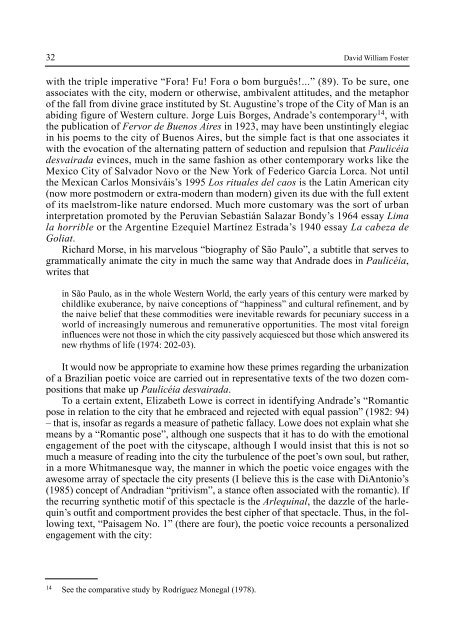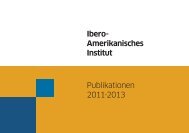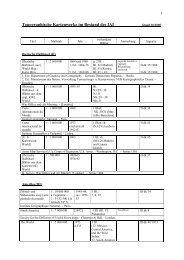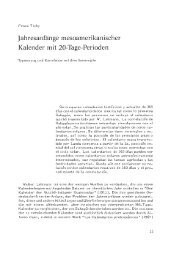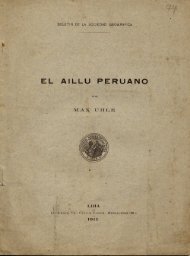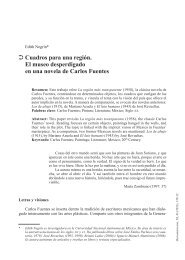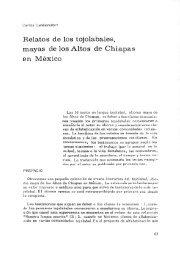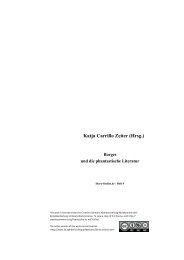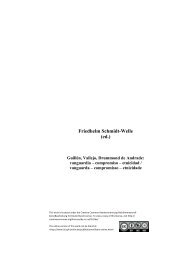Mário de Andrade: On Being São Paulo-wise in Paulicéia desvairada
Mário de Andrade: On Being São Paulo-wise in Paulicéia desvairada
Mário de Andrade: On Being São Paulo-wise in Paulicéia desvairada
You also want an ePaper? Increase the reach of your titles
YUMPU automatically turns print PDFs into web optimized ePapers that Google loves.
Rev19-01 22/8/05 13:17 Pág<strong>in</strong>a 32<br />
32 David William Foster<br />
with the triple imperative “Fora! Fu! Fora o bom burguês!...” (89). To be sure, one<br />
associates with the city, mo<strong>de</strong>rn or other<strong>wise</strong>, ambivalent attitu<strong>de</strong>s, and the metaphor<br />
of the fall from div<strong>in</strong>e grace <strong>in</strong>stituted by St. August<strong>in</strong>e’s trope of the City of Man is an<br />
abid<strong>in</strong>g figure of Western culture. Jorge Luis Borges, Andra<strong>de</strong>’s contemporary 14 , with<br />
the publication of Fervor <strong>de</strong> Buenos Aires <strong>in</strong> 1923, may have been unst<strong>in</strong>t<strong>in</strong>gly elegiac<br />
<strong>in</strong> his poems to the city of Buenos Aires, but the simple fact is that one associates it<br />
with the evocation of the alternat<strong>in</strong>g pattern of seduction and repulsion that <strong>Paulicéia</strong><br />
<strong>de</strong>svairada ev<strong>in</strong>ces, much <strong>in</strong> the same fashion as other contemporary works like the<br />
Mexico City of Salvador Novo or the New York of Fe<strong>de</strong>rico García Lorca. Not until<br />
the Mexican Carlos Monsiváis’s 1995 Los rituales <strong>de</strong>l caos is the Lat<strong>in</strong> American city<br />
(now more postmo<strong>de</strong>rn or extra-mo<strong>de</strong>rn than mo<strong>de</strong>rn) given its due with the full extent<br />
of its maelstrom-like nature endorsed. Much more customary was the sort of urban<br />
<strong>in</strong>terpretation promoted by the Peruvian Sebastián Salazar Bondy’s 1964 essay Lima<br />
la horrible or the Argent<strong>in</strong>e Ezequiel Martínez Estrada’s 1940 essay La cabeza <strong>de</strong><br />
Goliat.<br />
Richard Morse, <strong>in</strong> his marvelous “biography of <strong>São</strong> <strong>Paulo</strong>”, a subtitle that serves to<br />
grammatically animate the city <strong>in</strong> much the same way that Andra<strong>de</strong> does <strong>in</strong> <strong>Paulicéia</strong>,<br />
writes that<br />
<strong>in</strong> <strong>São</strong> <strong>Paulo</strong>, as <strong>in</strong> the whole Western World, the early years of this century were marked by<br />
childlike exuberance, by naive conceptions of “happ<strong>in</strong>ess” and cultural ref<strong>in</strong>ement, and by<br />
the naive belief that these commodities were <strong>in</strong>evitable rewards for pecuniary success <strong>in</strong> a<br />
world of <strong>in</strong>creas<strong>in</strong>gly numerous and remunerative opportunities. The most vital foreign<br />
<strong>in</strong>fluences were not those <strong>in</strong> which the city passively acquiesced but those which answered its<br />
new rhythms of life (1974: 202-03).<br />
It would now be appropriate to exam<strong>in</strong>e how these primes regard<strong>in</strong>g the urbanization<br />
of a Brazilian poetic voice are carried out <strong>in</strong> representative texts of the two dozen compositions<br />
that make up <strong>Paulicéia</strong> <strong>de</strong>svairada.<br />
To a certa<strong>in</strong> extent, Elizabeth Lowe is correct <strong>in</strong> i<strong>de</strong>ntify<strong>in</strong>g Andra<strong>de</strong>’s “Romantic<br />
pose <strong>in</strong> relation to the city that he embraced and rejected with equal passion” (1982: 94)<br />
– that is, <strong>in</strong>sofar as regards a measure of pathetic fallacy. Lowe does not expla<strong>in</strong> what she<br />
means by a “Romantic pose”, although one suspects that it has to do with the emotional<br />
engagement of the poet with the cityscape, although I would <strong>in</strong>sist that this is not so<br />
much a measure of read<strong>in</strong>g <strong>in</strong>to the city the turbulence of the poet’s own soul, but rather,<br />
<strong>in</strong> a more Whitmanesque way, the manner <strong>in</strong> which the poetic voice engages with the<br />
awesome array of spectacle the city presents (I believe this is the case with DiAntonio’s<br />
(1985) concept of Andradian “pritivism”, a stance often associated with the romantic). If<br />
the recurr<strong>in</strong>g synthetic motif of this spectacle is the Arlequ<strong>in</strong>al, the dazzle of the harlequ<strong>in</strong>’s<br />
outfit and comportment provi<strong>de</strong>s the best cipher of that spectacle. Thus, <strong>in</strong> the follow<strong>in</strong>g<br />
text, “Paisagem No. 1” (there are four), the poetic voice recounts a personalized<br />
engagement with the city:<br />
14 See the comparative study by Rodríguez Monegal (1978).


